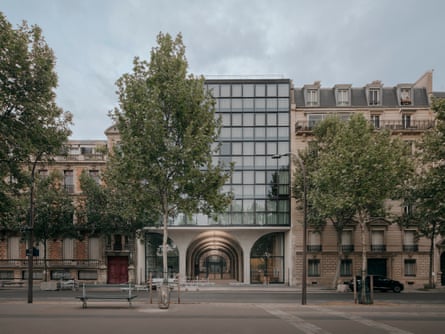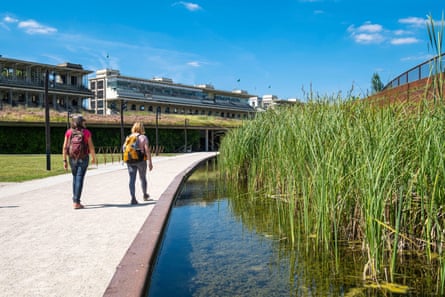Every four years, when the summer Olympics and Paralympics come round, a parade of architectural baubles – stadiums, velodromes, symbolic whatnots such as London 2012’s ArcelorMittal Orbit – is offered to the more or less fascinated gaze of the world. Each time, the question of legacy arises. What use will these structures have when their few weeks of glory is over? Answers run from the rotting facilities left by Athens in 2004 to the compromise whereby London’s Olympic stadium became the home of West Ham United football club.
Paris, the host city in 2024, promises to be different. Most of the events will be held in existing structures such as the Stade de France, originally built for the 1998 football World Cup, or in temporary venues in the heart of the city. Beach volleyball and blind football will take place in front of the Eiffel Tower, BMX freestyle and skateboarding in the Place de la Concorde. The opening ceremony will be a 6km-long river parade through what the official blurb calls the “impressive playing field the athletes will make their own as soon as it ends, the City of Light itself”.
The ex-rugby player Pierre Rabadan, now Paris’s deputy mayor in charge of sport and the Olympics, tells me that the Games’ “emblematic” project is not a building at all, but the “reconquest” of the Seine. It is being cleaned up, so that marathon swimming and triathlons can be held there, and the public can then swim in it for perpetuity. This is part of a €1.4bn national, regional and city project, the plan baignade, to cleanse the river from its source to the sea. It also reinforces the ambition of the mayor, Anne Hidalgo, to turn Paris into what in more hyperbolic moments is called “the greenest big city in Europe”.
She wants to make it a paradise of low pollution and healthy living, as friendly to pedestrians and bicycles as can be, with new developments planned to promote community life. This is a long-term endeavour, going back to Hidalgo’s predecessor Bertrand Delanoë, who was mayor from 2001 to 2014, but the Olympics have been enlisted to give it a boost. In the face of what Rabadan calls “a lot of political resistance”, the Olympics “gave us the opportunity to accelerate the transformation we need”.
The programme included the removal of traffic from the left and right banks of the Seine, in 2013 and 2016 respectively, which had been expressways since the 1960s. Important public spaces have been made progressively more pedestrian-friendly, such as the Place de la République in 2014 and the Place de la Bastille in 2020. An “urban forest” of 478 trees is now being planted in the Place de Catalogne, a large traffic roundabout near the Gare Montparnasse. There are plans to make the Champs-Élysées into a pedestrian-friendly “extraordinary garden”.

Other items in this pro-pedestrian, pro-bike, pro-tree, anti-car banquet include 1,000km of cycle lanes and 200,000 new street trees. Paris Respire (Paris Breathes), the scheme whereby parts of the city are closed to motorised traffic for one Sunday a month, has been running since 2016. A proposal to triple parking charges for SUVs will be put to a referendum in February. There are small-scale and local changes, as well as the transformations of the city’s most famous places. Three hundred rues aux écoles have been created, streets outside schools where traffic has been removed so that parents and children can gather and linger, with another 100 due by 2025. In some streets, parking spaces have been replaced by trees and planters. “Traffic limited zones”, into which only permit-holders can drive, will be installed in areas where the Olympic Games will be held and kept after they are over.
The pursuit of civilised urban life extends to 11 projects completed under the heading of Réinventer Paris, with another 11 on the way, where consortia competed to develop publicly owned sites, on condition that they achieve such desirables as sustainable construction and design, the encouragement of urban agriculture, and the mixture of uses and social groups. One example is Îlot fertile by the Paris-based TVK, billed as the “first zero carbon district in Paris”. Here, homes and places of work are arranged, in blocks partly built in environmentally friendly stone, around gardens and allotments.
Another is Morland Mixité, by the British architect David Chipperfield, and the local practice BRS, where a 1950s civic building has been converted into a “lively campus” containing a youth hostel, flats at both market and subsidised prices, a food market, kindergarten, bicycle repair shop and a luxury hotel and restaurant. There are arcades, reportedly inspired by the 17th-century Place des Vosges, although their parabolic concrete vaults have more of a 60s space-age feel about them. There are densely planted courtyard and rooftop gardens by the landscape architect Michel Desvigne, using “organic cultivation methods”, and a permanent art installation by Olafur Eliasson’s Studio Other Spaces, an “immersive optical apparatus” that reflects Parisian street life into the ceilings of the top two floors of the project’s central tower.
These changes are not universally popular. Various forms of traffic apocalypse have been predicted, at least since the closure of the Seineside highways, without coming to pass. A campaign on X, #saccageparis, which roughly translates as Trashed Paris, highlights such things as overflowing litter bins, unregulated street traders and the loss of historic ironwork, which its anonymous contributors say are more pressing issues than Hidalgo’s green ambitions. It’s rightly pointed out that the suburbs of Paris are more in need of investment and creativity than the urbanistically blessed arrondissements in her jurisdiction.

It’s true that the design quality of the interventions is not at the level of Adolphe Alphand, the 19th-century engineer whose parks and street furniture complemented the boulevards laid out by Baron Haussmann, or Hector Guimard’s art nouveau entrances to Métro stations. They tend to have an improvised air, with small areas of planting battling to thrive in expanses of paving. Emmanuel Grégoire, deputy mayor in charge of urbanism, tells me that at least some of these arrangements are temporary and will be improved. The priority has been to get things done: “If you wait for something to be perfect, it’s too long.”
Perhaps the worst thing you can say about Hidalgo’s projects is that rhetoric has a way of outrunning reality. Some of the “urban forests” promised for major spaces are not going to happen, and the Réinventer Paris programme, launched in 2014, is taking its time to be implemented. Some of the new planting looks a bit paltry – even allowing that it needs time to grow – and compromised, with bits of verdure shoehorned between vehicles.

The “15-minute city” – the concept promoted by the Franco-Colombian urbanist and adviser to Hidalgo, Carlos Moreno – also looks overhyped. This proposes that cities be planned in such a way that everything you might need for everyday life – workplace, shops, schools, places of leisure and sport – are within a quarter-hour journey from your home on foot or by bike, in order to strengthen communities and reduce car use. It has achieved some international fame, thanks to right-wing conspiracy theories that see it as an insidious attempt by global elites to take away personal freedoms.
In Paris, the 15-minute city is everywhere and nowhere. On the one hand, the historic city is already an almost-perfect embodiment of the idea, given that a quarter-hour radius from almost any point will cover a rich array of life and culture. On the other, it’s hard to find much evidence that its present-day application to planning policy is making much of a difference to the lives of Parisians. The problem with the 15-minute city may be less that it’s a fiendish plot by lizard people, than that it’s a bit vapid.

But there’s no doubt that such things as a 1,000% increase in cycling and the opening up of the riverbanks to pedestrians and swimmers will be significant achievements. The Olympic endeavour, as in the lead-in to almost every edition of the Games, comes with some nervousness as to whether everything will be ready, but the decision to make the best of the city’s considerable urban assets, rather than add new architectural trophies, is hard to fault.
In the 1980s and 90s, architectural writers made pilgrimages to Paris to see its grands projets – the Louvre Pyramid, the giant cubic “arch” at La Défense, the slightly tacky Opéra Bastille, which themselves were heirs to the Centre Pompidou and the Eiffel Tower. Now we find ourselves gazing at cycle lanes and shrubs. Given that Paris is already well stocked with monuments, the current desire to make it more enjoyable and healthy for its citizens looks absolutely right.

Comments (…)
Sign in or create your Guardian account to join the discussion